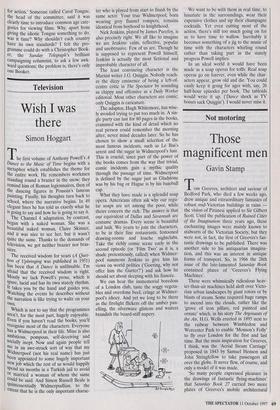Not motoring
Those magnificent men
Gavin Stamp
These were whimsically ridiculous heav- ier-than-air machines held aloft over Victo- rian urban landscapes by giant rotors or by blasts of steam. Some required huge ramps to ascend into the clouds, rather like the 'grove of iron pillars, red painted and ornate' which, in his story The Argonauts of the Air, H.G. Wells erected in 1895 next to the railway between Wimbledon and Worcester Park to enable 'Monson's Folly' to fly over London for the first and last time. But the main inspiration for Greeves, I think, was the 'Aerial Steam Carriage' proposed in 1843 by Samuel Henson and John Stringfellow to take passengers all over the globe. It never flew, of course, and only a model of it was made.
'So many people expressed pleasure in the drawings of fantastic flying-machines' that Saturday Book 27 carried two more plates of Greeves's mobile architectural contraptions. Best was the double-page spread of 'A Steam Palace' — a great Ruskinian juggernaut, higher than a church steeple, with tiers of pointed windows and a driver's cab in the form of a Gothic shrine in front of a more Romanesque- looking boiler. It was, of course, again enchantingly preposterous, but this time Greeves's fantasy was inspired by machines which had actually been built — and worked.
It is often forgotten that, before the rail- way became firmly ascendant, steam power was also used for locomotives which ran on the new macadamised turnpike roads rather than on wrought-iron rails. Richard Trevethick experimented with them in Cornwall in 1801, and by the 1830s a num- ber of steam carriages were regularly carry- ing fare-paying passengers. These really were horseless carriages as many of them resembled stagecoaches with a boiler and chimney at the rear. With such vdhicles, Sir Charles Dance began a service between Gloucester and Cheltenham in 1831 using the efficient boiler and engine developed by Sir Goldsworthy Gurney a few years ear- lier, and in the same year Walter Hancock ran steam carriages between London and Stratford in Essex. So successful were these that Hancock began a service between Paddington and Bank soon after, running along the New Road — now the Euston and City Roads. His best vehicle was the 'Automaton', a steam charabanc which once carried 70 passengers along the Bow Road at 21 mph.
But early horseless road travel was no safer than by early railway. The service of steam carriages operated by John Scott Russell between Glasgow and Paisley in 1834 came to a sudden and dramatic end after four months when — possibly as a result of sabotage — a boiler exploded, killing five people. The Court of Session then obliged by ordering the steam car- riages off the roads. But it was not explo- sions or other accidents which killed the reasonable hope that steam carriages could operate on roads all over Britain. Rather it was the blinkered greed of the turnpike trusts. Although these had improved and maintained the roads, they deterred steam carriages from using them by imposing ferocious tolls. This left the railway to con- nect the cities of Britain and inaugurate the age of mechanical mass transport.
Perhaps that was a pity: John MacAdam — the road builder — considered the advent of the railways a tragedy. The 1820s were the Golden Age of stagecoaches, thanks to Telford's magnificent turnpikes, and horses could have been replaced by steam. And the 1830s, the great railway his- torian, Hamilton Ellis, wrote, 'would have been the ideal time for the simultaneous development of mechanical haulage on both railways and the existing turnpikes'. Trunk railway lines were still needed for long journeys, but steam carriages could have coped with shorter runs, preventing, perhaps, the unnecessary proliferation of railway lines in Victorian Britain. On the other hand, they might have brought about the spoliation of towns and country all the sooner.
As it was, 'brilliantly and briefly as drag- onflies, the steam carriages appeared on British turnpikes ... then vanished from the eyes of men'. These machines were 'brave and beautiful', Ellis thought, as well as 'safe and handsome, and their engines, unlike early motor engines, almost noise- less'. I can see why Tom Greeves liked them and no longer find it puzzling that his mined urban landscapes were never com- plicated by viaducts, tunnels and the other massive structures thrown up by the Victo- rian railway engineer.



















































































 Previous page
Previous page